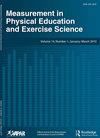Comparison between methods to estimate bicep femoris fascicle length from three estimation equations using a 10 cm ultrasound probe
IF 1.9
4区 教育学
Q2 EDUCATION & EDUCATIONAL RESEARCH
Measurement in Physical Education and Exercise Science
Pub Date : 2022-04-12
DOI:10.1080/1091367X.2022.2063689
引用次数: 1
Abstract
ABSTRACT The aim of the present study was to determine the reliability and differences between three fascicle length (FL) estimation methods when utilizing a 10-cm ultrasound (US) probe. Thirteen males (24.1 ± 3.8 years, 79.3 ± 14 kg, 179 ± 6.6 cm) participated. Bicep femoris long head (BFLH) US images were collected on two separate occasions. Three previously established extrapolation methods were utilized. Near-perfect reliability was observed for all methods. Criterion estimation resulted in a significant, trivial (p = 0.016,g = 0.17) increase in FL compared to the basic trigonometry equation with non-significant, trivial increase (p = 0.081,g = 0.10) between the criterion and partial measure method. The partial measure method was not significantly or meaningfully greater than the basic trigonometry method (p = 0.286,g = 0.08). Both alternative methods demonstrated unacceptable LOA (>5%), with heteroscedasticity. All methods of extrapolation are reliable and could be used over time. However, as methods are not comparable, there could be a rationale to utilize underestimated results to ensure a degree of cushioning.使用10cm超声探头从三个估计方程估计股二头肌束长度的方法比较
摘要:本研究的目的是确定在使用10厘米超声(US)探针时,三种束束长度(FL)估计方法的可靠性和差异。男性13名,年龄24.1±3.8岁,79.3±14 kg, 179±6.6 cm。股骨长头二头肌(BFLH)的美国图像采集于两个不同的场合。使用了先前建立的三种外推方法。所有方法的可靠性都接近完美。与基本三角方程相比,标准估计导致FL显著,微不足道(p = 0.016,g = 0.17)增加,而标准和部分测量方法之间没有显著,微不足道的增加(p = 0.081,g = 0.10)。部分测量法与基本三角法比较差异无统计学意义(p = 0.286,g = 0.08)。两种方法均显示出不可接受的LOA(>.5 %),且存在异方差。所有的外推方法都是可靠的,可以长期使用。然而,由于方法不具有可比性,可能有理由利用低估的结果来确保一定程度的缓冲。
本文章由计算机程序翻译,如有差异,请以英文原文为准。
求助全文
约1分钟内获得全文
求助全文
来源期刊

Measurement in Physical Education and Exercise Science
Medicine-Orthopedics and Sports Medicine
CiteScore
4.20
自引率
33.30%
发文量
24
期刊介绍:
The scope of Measurement in Physical Education and Exercise Science (MPEES) covers original measurement research, special issues, and tutorials within six substantive disciplines of physical education and exercise science. Six of the seven sections of MPEES define the substantive disciplines within the purview of the original research to be published in the journal: Exercise Science, Physical Activity, Physical Education Pedagogy, Psychology, Research Methodology and Statistics, and Sport Management and Administration. The seventh section of MPEES, Tutorial and Teacher’s Toolbox, serves to provide an outlet for review and/or didactic manuscripts to be published in the journal. Special issues provide an avenue for a coherent set of manuscripts (e.g., four to five) to collectively focus in-depth on an important and timely measurement-related issue within the scope of MPEES. The primary aim of MPEES is to publish high-impact manuscripts, most of which will focus on original research, that fit within the scope of the journal.
 求助内容:
求助内容: 应助结果提醒方式:
应助结果提醒方式:


